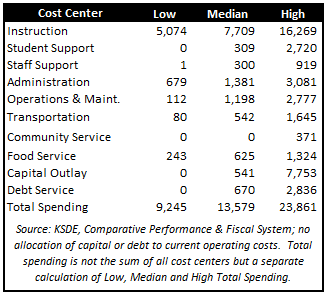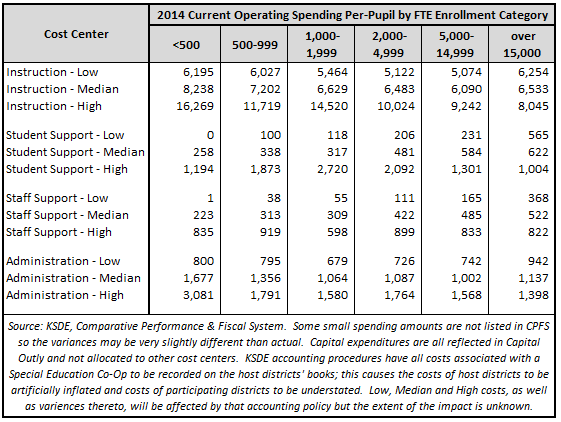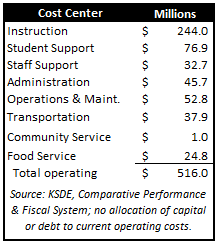 School districts spent an average $12,960 per student during the 2014 school year but the range of spending across districts varied quite significantly. Total spending went from a low of $9,245 per-pupil (USD 218 Elkhart, with 1,137 students) to a high of $23,861 (USD 490 El Dorado, 1,872 students); El Dorado also hosted a Special Ed Co-Op and must record the cost of serving students in other districts per KSDE. USD 359 Argonia had the highest spending per-pupil among districts that did not host Special Ed Co-Ops, spending $22,847 with 162 students enrolled.
School districts spent an average $12,960 per student during the 2014 school year but the range of spending across districts varied quite significantly. Total spending went from a low of $9,245 per-pupil (USD 218 Elkhart, with 1,137 students) to a high of $23,861 (USD 490 El Dorado, 1,872 students); El Dorado also hosted a Special Ed Co-Op and must record the cost of serving students in other districts per KSDE. USD 359 Argonia had the highest spending per-pupil among districts that did not host Special Ed Co-Ops, spending $22,847 with 162 students enrolled.
Instruction spending variances can be somewhat driven by the school funding formula and student body compositions (extra money is given to districts for special education, low income students and bi-lingual students) but districts have a great deal of latitude in resource allocation. Some districts, for example, divert money from Instruction as a result of other spending decisions. Variances in spending on Administration and other cost centers, however, are primarily driven by district operating decisions.
Many Kansas school districts have low enrollment, and while it would be expected that very small districts would spend more per-pupil because of economies of scale, some small districts are able to operate at lower prices per student than many larger districts. There are also wide variances even among districts of similar size.
Below is a complete analysis of all operating cost centers (including Operations / Maintenance, Transportation, Food Service and Community Service.
 To put these variances in perspective, KPI staff calculated the potential savings of getting each district spending above median within their enrollment category down to the median for each cost center. The total comes to a staggering $516 million. There may be some circumstances that preclude some of that savings being realized but there could also be additional savings realized among those districts spending below median.
To put these variances in perspective, KPI staff calculated the potential savings of getting each district spending above median within their enrollment category down to the median for each cost center. The total comes to a staggering $516 million. There may be some circumstances that preclude some of that savings being realized but there could also be additional savings realized among those districts spending below median.
To be clear, the purpose of this analysis is not to say that a specific dollar amount of savings could be had if districts operate more efficiently. However, variances of this magnitude certainly indicate that efficiency efforts driven by the Legislature could easily yield nine-figure savings.




